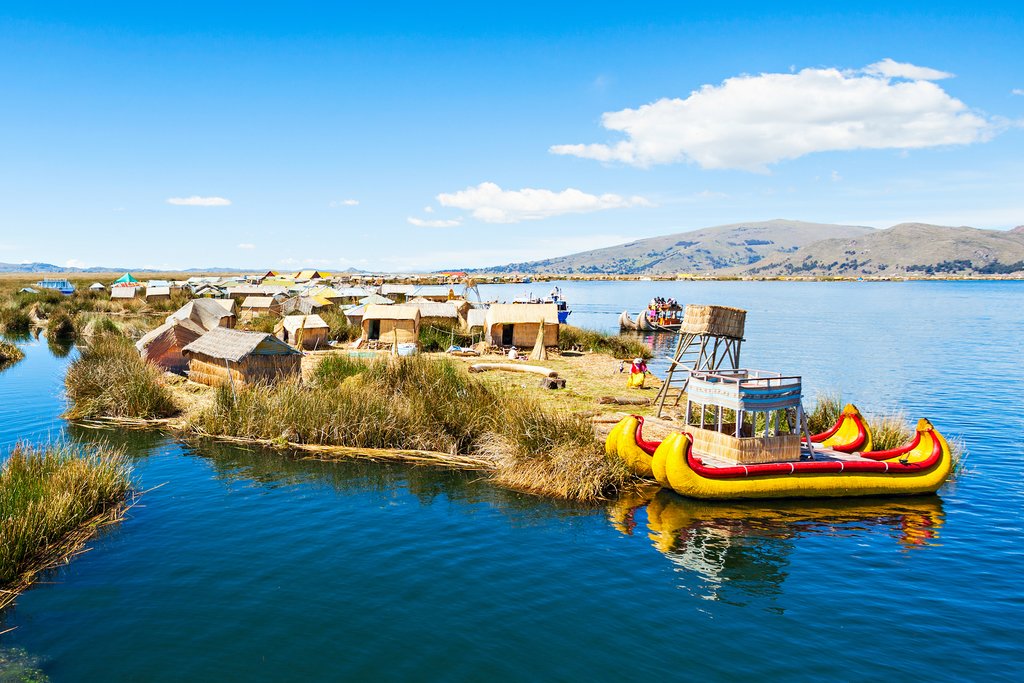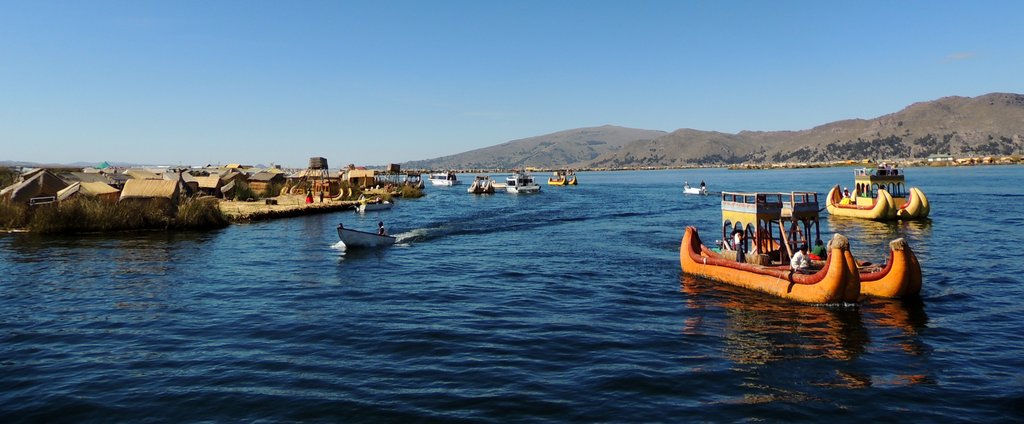Highlights
- Spend an afternoon enjoying the ocean views in Lima
- Float through the Amazon rainforest in a dugout canoe
- Tour Inca ruins and market towns in the Sacred Valley
- Hike around colorful rainbow-colored mountains at Palcoyo
- Explore the "floating islands" of Lake Titicaca
Brief Itinerary
| Day | Highlights | Overnight |
|---|---|---|
| Day 1 | Arrive in Lima & Get Oriented | Lima |
| Day 2 | Discover the Amazon | Puerto Maldonado |
| Day 3 | Go on Jungle Excursions to Tres Chimbadas & Parrot Clay Lick | Puerto Maldonado |
| Day 4 | Explore the Jungle in a Dugout Canoe | Puerto Maldonado |
| Day 5 | Travel to Cusco & Get Acclimated | Cusco |
| Day 6 | Sightsee in Cusco | Cusco |
| Day 7 | Tour Pisac & Ollantaytambo | Aguas Calientes |
| Day 8 | Visit Machu Picchu | Cusco |
| Day 9 | Trek Around Palcoyo Rainbow Mountain | Cusco |
| Day 10 | Enjoy a Scenic Drive from Cusco to Puno | Puno |
| Day 11 | Explore Lake Titicaca | Amantani Island |
| Day 12 | Discover the Floating Island of Taquile | Puno |
| Day 13 | Depart Peru - End of Trip |
Detailed Itinerary
Day 1: Arrive in Lima & Get Oriented

Welcome to Lima, Peru! The country's largest city is home to one-third of the country's population. Located at the site of a pre-Columbian indigenous settlement, conquered by the Inca empire in the 15th century and later by the Spanish conquistadores, Lima has a fascinating history and a diverse mix of cultures. Amerindian, European, Afro-Peruvian, and Asian — especially Chinese and Japanese — influences make Lima a dynamic and exciting city to explore.
Lima's breezy location on the Pacific Ocean makes it a perfect city for exploring on foot. Head downtown to mingle with locals, stretch your legs, and grab a bite to eat in one of many award-winning restaurants. Or take in views over the ocean in the clifftop neighborhood of Miraflores.
Day 2: Discover the Amazon

This morning you will transfer from your hotel to the airport for your flight to Puerto Maldonado. Upon arrival at the airport, transfer to the port for a boat journey along the Tambopata River. Arrive at Posada Amazonas Lodge. Get settled and review your activity options for the next couple of days. Kick back in a hammock and relax for the rest of the day, or if you'd prefer to get in a little adventure, take a trip in a dugout canoe to see some local wildlife, including a wide variety of tropical birds. After dinner at the lodge, you can go on a nighttime boat trip to search for caimans.
Day 3: Go on Jungle Excursions to Tres Chimbadas & Parrot Clay Lick

Today you will explore the lush rainforest around you in a series of short guided adventure treks. Start by heading to Tres Chimbadas. Explore the lake to search for the resident family of giant river otters and other local wildlife. Continue to the Parrot Clay Lick to watch hundreds of vibrant parrots and parakeets descend onto the river bank to eat the mineral-rich clay. Brightly-colored species like the Yellow-headed Amazon, Blue-headed Parrot, and Dusky Headed Parakeet love to visit this location — late morning is an ideal time to spot them.
Take a break for lunch, then take a botany tour with a community organization that derives natural medicines from plants found in the rainforest. After dinner, you'll have the option to go on a relaxing night hike during a time when most mammals are active. Listen to the chorus of from and amphibian calls, and bring a flashlight to try and spot the small animals as they camouflage in the vegetation.
Day 4: Explore the Jungle in a Dugout Canoe

Otters in the Amazon
After a beautiful sunrise and an early breakfast, visit a local farm to learn about traditional cultivation techniques and sample some of the produce. Stop at the nearby botanical garden and discover more of the immense variety of medicinal plants used by the indigenous people of the Amazon.
In the afternoon, head back to the lodge to enjoy lunch. Afterward, you will be treated to a trip in a dugout canoe to see some more local wildlife. Photographers and naturalists will love spotting Amazonian species around the water, so don't forget your camera. Relax and enjoy the beautiful scenery while observing tropical birds.
On the way back, disembark at the remains of the Fitzcarrald Steamboat, where you'll learn about its history and how it became part of an award-winning film "Fitzcarraldo."
Day 5: Travel to Cusco & Get Acclimated

After a magnificent sunrise, enjoy your last breakfast at the lodge. Then it's time to make your way back to civilization. Head to the airport to catch your flight to Cusco. This ancient city is the former capital of the Inca empire, which reigned from the 13th to 16th centuries. Remember: you will be 11,000 feet (3,000 m) above sea level, so take it easy and remember to drink lots of water.
Since Cusco was designed by the Incas as a city for walking, start your exploration of the narrow stone alleyways on foot. Take a walk through the plaza — if the weather is beautiful, it's a perfect place to sit on a balcony and have a cup of coca tea while adjusting to the elevation.
Day 6: Sightsee in Cusco

Day 7: Tour Pisac & Ollantaytambo

Chat with a local specialist who can help organize your trip.
This morning you will depart from your hotel in Cusco and travel to Pisac, one of the most important archaeological sites in the region. In this area, you'll explore ancient Inca burial grounds, irrigation systems, and astronomy centers. Next, go down to the town of Pisac, located at the bottom of the valley. This town is famous for its bustling textile market. Select from a wide assortment of colors, styles, and designs for gifts and souvenirs to take home with you.
Next, you'll stop for lunch, enjoying traditional Andean cuisine at a restaurant in a beautiful setting overlooking the Urubamba River. Then head to the ancient Incan city of Ollantaytambo, one of the few remaining places in the Sacred Valley that have retained their original Inca urban planning. Walk through the streets with Inca-era canals and view the ancient houses still in use today. Climb the agricultural terraces where you can enjoy an Inca’s-eye-view of the valley. From the top, you’ll be able to see some of the quarries from where the stone for Ollantaytambo was sourced. It’s amazing to think how far these large stones were transported from, especially considering the Incas didn’t have pack animals strong enough to carry them. Later in the day, catch a train to Aguas Calientes, the gateway to Machu Picchu. You'll have dinner in town before venturing to the site the next day.
Day 8: Visit Machu Picchu

Day 9: Trek Around Palcoyo Rainbow Mountain

Palcoyo Rainbow Mountain is only about 12.5 miles (20 km) from its famous sister Vinicunca. While Vinicunca attracts thousands of visitors, its smaller sister Palcoyo (16,000 ft/ 4900m) has fewer crowds and equal beauty. This mini trek is perfect for travelers who want to view the colorful rainbow mountains in a relatively shorter and more gentle trek, and a great option for those traveling with kids.
Start the morning with an early pickup. You'll stop for breakfast along the way. Your drive this morning will be along the Red River, with plenty of opportunities for photos and stops. The drive will take roughly 3.5 hours, after which you'll arrive at the starting point of the short hike. From here, the hike is approximately an hour via a short, relatively flat path. Along the way, you'll see llamas, sheep, vicuñas, and alpacas. The summit lies about 16,400 ft (5,000 m) above sea level. Once you reach the top, you'll have time to enjoy the panorama and take pictures.
At this point, it is time to hike downhill. Once you reach the bottom, start the drive back to Cusco. You'll have the evening free to relax.
Day 10: Enjoy a Scenic Drive from Cusco to Puno

You'll ride to Puno today by bus, visiting several interesting attractions along the way. First, you'll visit the famous Andahuaylillas Church, known as the "Sistine Chapel of America" because of its beautiful paintings. Continue along the route, enjoying breathtaking views of snow-capped mountains in the background, to Tambo Queque Norte, an Andean country manor that dates back to colonial times. Proceed to Tinajani Canyon to see peculiar rock formations and spectacular scenery. Spend the night in Puno.
Day 11: Explore Lake Titicaca

Day 12: Discover the Floating Island of Taquile

Day 13: Depart Peru - End of Trip

Today the trip comes to an end. You'll transfer to the airport to catch a flight out. Safe travels!
More Peru Itineraries
Looking for more inspiration for your trip to Peru? Check out these other Peru itineraries, with outdoor adventures, cultural trips, and best-of tours to hit the highlights.
Or, describe your ideal trip and we will connect you with a local specialist to make it happen.
